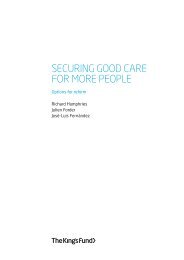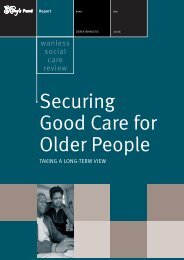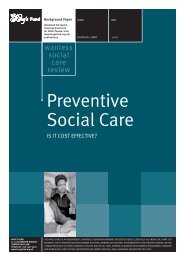Time and other inputs for high quality social care - The King's Fund
Time and other inputs for high quality social care - The King's Fund
Time and other inputs for high quality social care - The King's Fund
You also want an ePaper? Increase the reach of your titles
YUMPU automatically turns print PDFs into web optimized ePapers that Google loves.
of the <strong>care</strong>r were important predictors of sufficiency ratings from both perspectives. Care<br />
recipients rated the sufficiency of <strong>care</strong> <strong>for</strong> ADLs <strong>and</strong> IADLs (medication management,<br />
shopping, bathing, housekeeping <strong>and</strong> money management) <strong>high</strong>er than the nurses<br />
assessing them. Nurses gave <strong>high</strong>er sufficiency ratings <strong>for</strong> transport support than did the<br />
recipients of <strong>care</strong>. <strong>The</strong> two groups’ ratings of the sufficiency of help with grooming,<br />
dressing <strong>and</strong> meal preparation did not differ significantly.<br />
User experiences, satisfaction <strong>and</strong> person-centred <strong>care</strong><br />
<strong>The</strong>re is an extensive body of English-language qualitative literature on users’ experiences<br />
of home <strong>care</strong> <strong>and</strong> their levels of satisfaction from the United States <strong>and</strong> Canada, Sweden<br />
<strong>and</strong> the United Kingdom. Most of the UK papers that were eventually located were not<br />
indexed by the majority of the bibliographic databases, 1 because they had been published<br />
in the <strong>for</strong>m of reports rather than journal articles.<br />
<strong>The</strong> UK literature on home <strong>care</strong> does address the issue of <strong>quality</strong>. <strong>The</strong>se studies identify a<br />
number of factors that contribute to the <strong>quality</strong> of home <strong>care</strong>: the attitudes <strong>and</strong> training of<br />
staff; the responsiveness of <strong>care</strong> to the needs of recipients; <strong>and</strong> the reliability of the <strong>care</strong>.<br />
Although these studies judge <strong>quality</strong> in terms of the perceptions of users, <strong>care</strong>rs <strong>and</strong><br />
providers rather than objective outcomes, their findings are extremely consistent. Most of<br />
the studies included in the literature review were purely qualitative (Patmore 2001, Raynes<br />
<strong>and</strong> Joseph Rowntree Foundation 2001, Patmore 2004, Patmore 2005), but a couple<br />
employed mixed methods (Sinclair et al 2000, Curtice et al 2002) <strong>and</strong> one was quantitative<br />
(Netten et al 2004).<br />
Through user focus groups, one relatively small-scale study (Henwood et al 1998)<br />
identified that <strong>quality</strong> home <strong>care</strong> service meant: staff reliability; continuity of <strong>care</strong>; staff’s<br />
kindness <strong>and</strong> underst<strong>and</strong>ing; their cheerfulness or demeanour; their competence in<br />
specific tasks; their flexibility in responding to the needs or requirements of <strong>care</strong><br />
recipients; <strong>and</strong> their knowledge <strong>and</strong> experience of the needs <strong>and</strong> wishes of the service<br />
user.<br />
Research conducted by the Social Policy Research Unit at York University on personcentred<br />
home <strong>care</strong>, which was reported in two articles focusing on <strong>quality</strong> (Patmore 2001,<br />
2004), gives the following examples of good <strong>quality</strong>-practice <strong>and</strong> poor-<strong>quality</strong> practice.<br />
Good <strong>quality</strong> practice<br />
• An independent sector home <strong>care</strong> manager described that although 45–60 minutes<br />
was allowed <strong>for</strong> a morning <strong>care</strong> visit, it was possible to accomplish the required tasks in<br />
30–35 minutes, leaving 10–15 minutes <strong>for</strong> <strong>quality</strong> time to wash up or have a cup of tea<br />
or a chat.<br />
• <strong>The</strong> researchers found that some providers would do pet <strong>care</strong> <strong>and</strong> extra cleaning, find<br />
plumbers/h<strong>and</strong>ymen <strong>for</strong> people <strong>and</strong> change light bulbs (although there were <strong>other</strong><br />
providers that <strong>for</strong>bade this).<br />
Poor <strong>quality</strong> practice<br />
• In some local authorities, providers said the visit lengths commissioned were so short<br />
that no spare time could arise.<br />
EVIDENCE FROM THE REVIEW 7
















